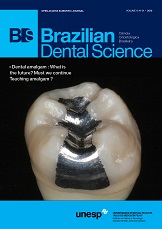The effect of piezosurgery with cvd tip in osteotomy in rat parietal bone: histologic and histomorphometric analysis
DOI:
https://doi.org/10.14295/bds.2015.v18i1.1052Abstract
Objective: The aim of this study was to compare the response of bone tissue in osteotomy under piezosurgery using a CVD tip in rat parietal bone in contrast with the standard protocol using low-speed tungsten burs. Material and Methods: A bone defect model was created in parietal bone of 20 male Wistar rats using CVD tip and drill. Five animals were sacrificed after 3, 7, 14 and 28 days and the bone containing the defects was submitted to the histologic and histomorphometric analysis. The results of histomorphometry were statistically analyzed using RM ANOVA with a significance level of ? = 0.05. The results were still subjected to Tukey's multiple comparison test. Results: The results showed statistically significant difference (p <0.05) between the two types of treatment in the analyzed periods. Piezosurgery promoted slower and more precise cut with less bone loss and less bleeding during surgery, promoting conditions for a faster repair compared to the traditional method of osteotomy, fewer inflammatory cells, faster bone formation, cleaner surgical wound in the experimental group in all periods. Conclusion: It was concluded that the use of CVD tip in piezosurgery was proven to be valid for osteotomy, with more precise cuts, less tissue damage, fewer pronounced inflammatory response and faster bone formation in the early periods when compared with low-speed tungsten burs.
Downloads
Downloads
Published
How to Cite
Issue
Section
License
Brazilian Dental Science uses the Creative Commons (CC-BY 4.0) license, thus preserving the integrity of articles in an open access environment. The journal allows the author to retain publishing rights without restrictions.
=================




























